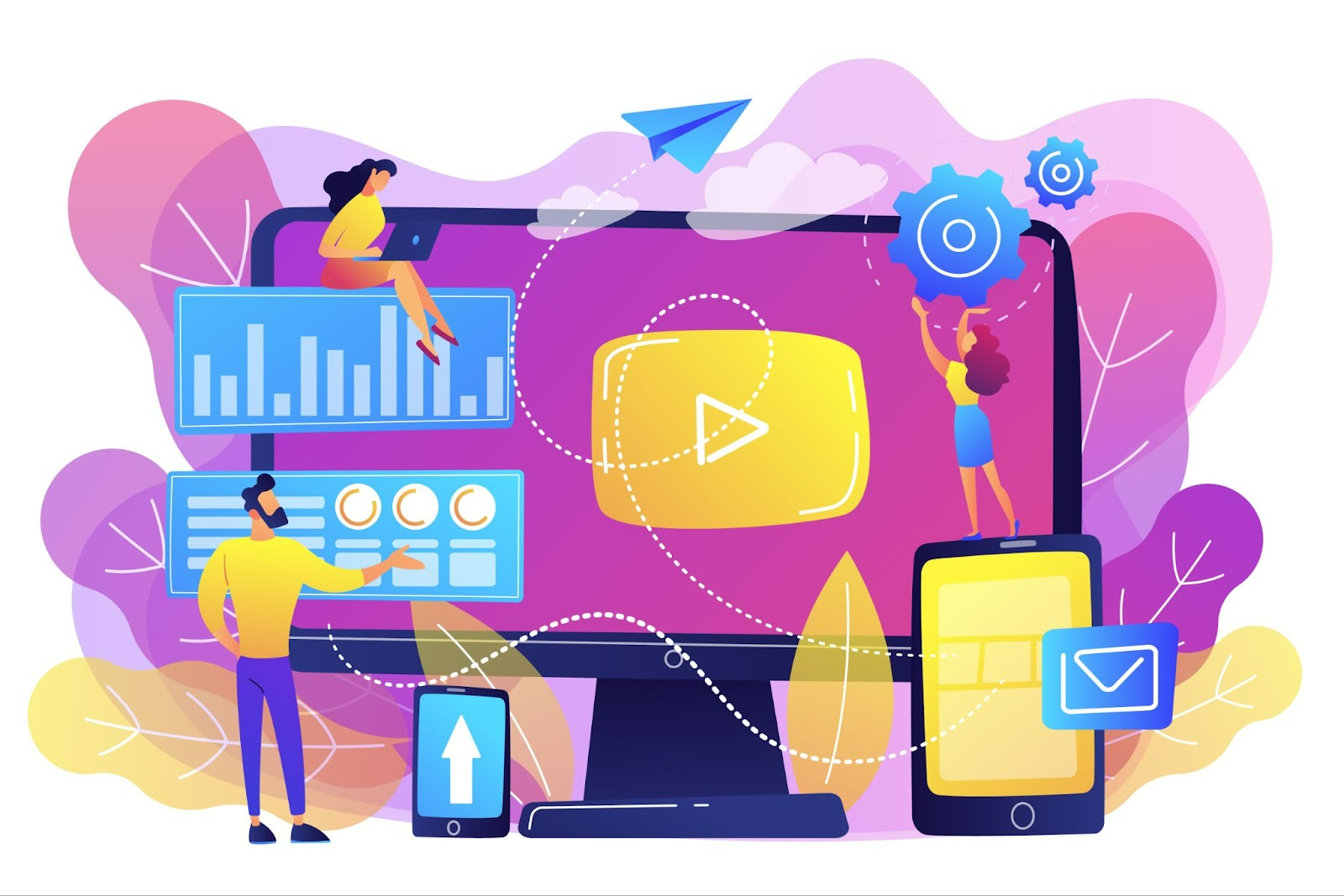
How Video Marketing Can Increase Event Audience
Planning an event is no small feat, and ensuring a strong turnout is crucial. With video expected to account for 82% of all internet traffic by 2024, according to Cisco, leveraging its power in your event promotion becomes indispensable. So, how do you captivate your potential attendees and guarantee they mark their calendars?
The Power of Video Marketing:
- Engagement: Captures attention instantly.
- Storytelling: Shares the event’s narrative and value.
- Visual Appeal: Creates a lasting impression.
Did You Know: Incorporating video into your event promotion can skyrocket interest and attendance. Landing pages with video content can boost conversion rates significantly.
A Guide to Transform Your Event: In the following sections, we’ll explore:
- Strategies to leverage video content pre-, during, and post-event.
- Real-life examples of events transformed by video marketing.
- Tips and tricks to create compelling video content.
Are you prepared to unlock the secrets of video marketing and see your event attendance soar? Let’s embark on this journey together, turning potential into presence and making your event a must-attend!
The Power of Video in Event Marketing
Video marketing has revolutionized the way businesses and individuals promote events. Platforms like YouTube, TikTok, and Instagram have made video content an essential tool for event marketing, offering a detailed guide on event marketing through visual storytelling and audience engagement. Here’s why:
- Statistics Speak Volumes: According to HubSpot, 54% of consumers want to see more video content from a brand or business they support. Additionally, a study by Eventbrite suggests that events promoted with video content see a 30% increase in ticket sales. Jewelry wholesalers can also benefit from this trend by using video marketing to showcase their products and connect with their audience.
- Differentiating Video Content: Unlike traditional forms of marketing like print ads or radio spots, video content offers a dynamic and engaging experience. It allows for storytelling, showcasing event highlights, and giving potential attendees a sneak peek into what to expect.
- Personal Touch: Videos can feature testimonials from previous attendees, behind-the-scenes looks, or messages from keynote speakers, adding a personal touch that other marketing forms lack.
- Shareability: Videos are easily shareable across social media platforms, increasing the event’s reach and potential attendance.
- Real-life Success Stories:
- TED Talks: One of the most prominent examples of successful event promotion through video is TED Talks. They’ve garnered millions of views and established a global brand by sharing videos of their talks online.
- Coachella Music Festival: Their after-movie recaps and lineup announcements generate millions of views on YouTube, creating buzz and anticipation for the next event.
- Fashion Shows: The fashion industry is known for its glamorous runway clips released before, after, and even during global fashion weeks to make sure the conversation remains active on social platforms and to ensure the collections are viewed by more people around the world.
Video into your event marketing strategy boosts ticket sales and enhances brand visibility and engagement. As the digital landscape continues to evolve, video content remains a powerful tool for making events successful.
Types of Event Videos and Their Impact
“Before hitting ‘upload’ on YouTube, a pro tip from Search Nation suggests optimizing your video’s SEO can significantly boost your views. They estimate that a well-optimized video can see up to a 50% increase in search-related visibility. It’s all about playing the YouTube game smartly!”
In event marketing, video content is a versatile and impactful tool, offering various formats to captivate audiences and boost attendance. Each type of event video plays a unique role in the event lifecycle, contributing to a comprehensive and effective marketing strategy. Here’s a deeper dive into how different types of event videos make an impact:
- Teasers: Teasers often include sneak peeks, intriguing visuals, or mysterious messages to grab attention, making them an effective strategy to sell tickets for all events. They leave the audience wanting more, generating buzz and curiosity among potential attendees. This ignites interest and anticipation, creating a sense of excitement around the event.
- Purpose: Generate buzz and curiosity among potential attendees.
- Impact: Ignites interest and anticipation, creating a sense of excitement around the event.
- Example: Apple’s product launch teasers are a prime example, as they create a frenzy of speculation and discussion, driving millions to tune in live and increasing the event’s visibility.
- Promotional Videos: These videos often include testimonials, highlights from previous events, and a clear call to action to guide potential attendees toward registration.
- Purpose: Highlight the event’s key details, benefits, and unique selling points.
- Impact: Encourages registrations by showcasing the value and experiences attendees can expect.
- Example: TEDx events utilize promotional videos to spotlight their speakers, themes, and unique experiences, driving ticket sales and attendee interest.
- Recaps: Recap videos are a powerful tool for post-event marketing, keeping the event in attendees’ minds and maintaining momentum for future events.
- Purpose: Showcase the event’s highlights, successes, and best moments.
- Impact: Creates a sense of FOMO (Fear Of Missing Out) for future events, encouraging past attendees to return and new attendees to join.
- Example: The Coachella music festival’s after-movies turn event highlights into a viral sensation, ensuring that the following year’s event is eagerly anticipated and likely to be a sell-out.
- Live Streams: Live streaming requires careful planning and promotion to ensure a smooth viewing experience, and it provides an opportunity for real-time interaction and engagement with the online audience.
- Purpose: Extend access to the event to a global audience, breaking geographical barriers.
- Impact: Increases reach and engagement in real-time, allowing those who couldn’t attend in person to be part of the experience.
- Example: Gaming conventions like E3 livestream their presentations and announcements, attracting millions of online viewers and creating a global buzz.
Each video type serves a unique role, from sparking initial interest with teasers to maintaining post-event engagement with recaps. By strategically integrating these video formats into your event marketing plan, you’re setting the stage for a whole house.
Crafting Compelling Event Videos
Creating compelling event videos is an art form that requires a keen understanding of your audience, a creative touch, and a strategic approach to content creation. Here’s how you can craft videos that not only capture attention but also leave a lasting impact:
Understanding Your Audience:
- Why It’s Crucial: Knowing who you are creating content for is the first step in crafting a message that resonates.
- How to Do It: Conduct audience research to understand their preferences, interests, and behavior. What type of content do they engage with? What are their pain points and aspirations?
- Pro Tip: Understanding your audience is crucial when crafting event videos. By conducting audience research, you can uncover their preferences, interests, and behavior, leading to event ideas for organizers that resonate and engage. What type of content do they engage with? What are their pain points and aspirations?
Crafting Audience Personas: A Quick Guide
- Step 1: Gather Data
- Surveys, social media analytics, attendee feedback.
- Look for age, profession, and interests.
- Step 2: Identify Common Characteristics
- What motivates them to attend?
- Any shared challenges or goals?
- Step 3: Create Personas
- Segment the information.
- Develop a detailed profile for each segment.
- Step 4: Utilize Content Creation
- Tailor your video content to each persona.
- Ensure resonance and target effectiveness.
Outcome: Enhanced engagement, better-targeted content, and increased event attendance.
Critical Elements of Engaging Videos:
- Storytelling: Weave a narrative that takes your audience on a journey, showcasing the value and uniqueness of your event.
- Visual Appeal: Invest in high-quality visuals and animations to create a professional and engaging viewing experience.
- Clear Call-to-Action: Guide your viewers on what to do next, whether registering for the event, sharing the video, or visiting your website.
Best Practices for Video Production:
- Plan Your Content: Outline your key messages, visuals, and the overall flow of the video before diving into production.
- Focus on Quality: Ensure that your video’s visual and audio elements are of the highest quality.
- Keep It Concise: Attention spans are short, clear, and concise your message, ensuring that crucial information is conveyed within the first few seconds.
Leveraging User-Generated Content and Social Media:
- Why It Works: Authentic content from previous attendees adds credibility and relatability to your message.
- How to Do It: Encourage your community to share their experiences and testimonials and incorporate this content into your event videos.
- Maximizing Social Media: Use platforms like Instagram, TikTok, and Facebook to share your videos, reach a wider audience, and create a buzz around your event.
Attention to these critical elements and best practices sets the stage for event videos that stand out and drive action, ensuring your event is top of mind and on the must-attend list.
Conclusion
In the dynamic landscape of event marketing, video content is a transformative tool, enhancing attendee engagement and utilizing event management tools for streamlining events to ensure success. From the initial buzz created by teasers to the lasting impact of recap videos, each type of event video plays a crucial role in the event lifecycle.
The power of video marketing lies in its ability to engage audiences through storytelling, visual appeal, and a personal touch that other forms of marketing struggle to match. Real-life success stories from global phenomena like TED Talks and the Coachella Music Festival underscore the potential of video content to boost ticket sales, enhance brand visibility, and foster a sense of community among attendees.
As we navigate the ever-evolving digital landscape, the importance of understanding your audience and crafting compelling, targeted video content has never been greater. By leveraging user-generated content and maximizing the reach of social media, event organizers can unlock the full potential of video marketing, transforming interest into attendance and ensuring their event stands out in a crowded market.
In conclusion, the transformative power of video marketing is undeniable. It is a vital asset for any event organizer looking to increase attendance, create buzz, and ensure the success of their event. The call to action is clear: embrace video marketing, harness its potential, and make your next event a success.
Latest Posts
-
Japan, South Korea Lead 157% AI App Growth as Users Hit 666M
-
How to Optimise Your Videos for SEO
-
Data-Driven Influencer Selection in Video Marketing
-
How to Use Video Walkthroughs to Transform Your Real Estate Marketing Strategies
-
How Web Hosting Impacts Video Marketing Success: A Guide for Small Businesses


